

Metal detecting holidays in England with the World's most successful metal detecting club.
Twinned with Midwest Historical Research Society USA
|
Sept 2005 Finds Page 1 |
|||
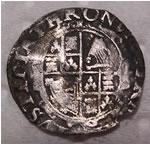 |
 |
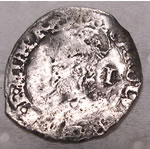 |
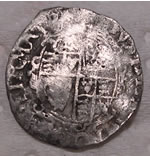 |
|
1640's Charles
1st hammered silver penny
|
1640's
Charles 1st hammered silver penny
|
||
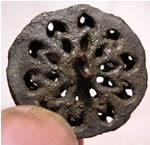 |
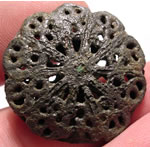 |
 |
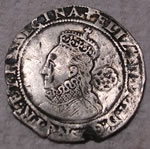 |
|
Huge
late 16th early 17th C button
|
Elizabeth
1st 1580 hammered silver sixpence 4th issue 0.92 fine
|
||
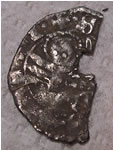 |
 |
 |
 |
|
1300
AD VenetianSoldino
hammered silver coin
|
Elizabeth
1st 1578 hammered silver sixpence 0.92 fine
|
||
 |
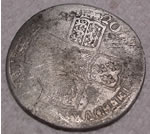 |
 |
 |
|
1720
George 1st milled silver shilling
|
Monogrammed
button
|
18thC
Harness pendant
|
|
 |
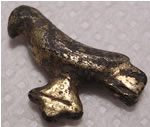 |
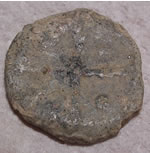 |
|
|
Duck mount
possibly Tudor period
|
Small gild
bird - no idea of date yet
|
15thC long cross lead token |
|
 |
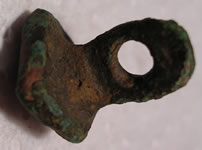 |
||
| Medieval cross possibly from local monastery |
Mid 16thC
pyramid button - first of that design found here
|
||
 |
 |
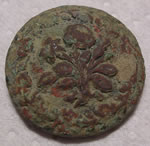 |
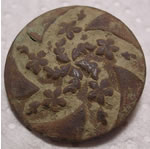 |
|
Nice condition
1797 George III cartwheel penny
|
1696
William III copper
|
19thC
flower button
|
19thC
flower button
|
 |
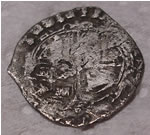 |
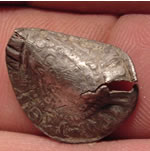 |
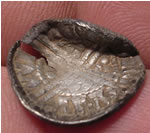 |
|
1640's
Charles 1st hammered silver one pence
|
1215
AD Henry III voided long cross hammered silver penny
|
||
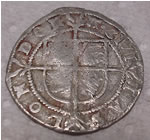 |
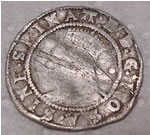 |
 |
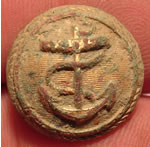 |
|
Just
back from the jewelers - straightened 1582 Elizabeth 1st half groat
|
Early
Navy captains button
|
||
 |
 |
 |
|
|
Interesting
strap end - probably post Medieval
|
17thC
trade farthing
|
||
 |
 |
||
|
18thC ornate
'nutcracker' fragment
|
9thC clothing
hanger fragment
|
||
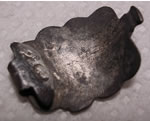 |
 |
 |
 |
|
18thC solid
silver clog fastener
|
1830 -1837
William IIII silver sixpence
|
1625 Charles
1st hammered copper Rose farthing
|
|
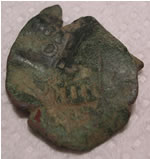 |
 |
 |
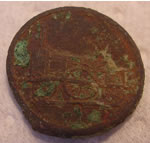 |
|
1641 8 Maravedis
revalidated with VIII counterstamp on 8 Maravedis of 1625 of uncertain
mint, Felipe IV (1621-1665) of Spain
|
Early
Navy captains button
|
Ink well
cover
|
Stevenson's
rocket button - worlds first ever steam train
|
 |
Latin inscription on lead Possible Roman but lettering is more like 17thC- not investigated yet Turns out to be the name of a plant LOL |
||
 |
|||
 |
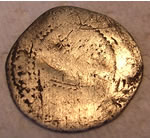 |
 |
 |
|
James 1st
1605 hammered silver half groat (2 pence)
|
1327 AD Edward III hammered silver half penny 7g London mint Possible type 5 |
||
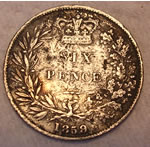 |
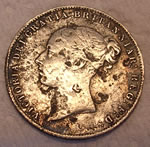 |
 |
 |
|
1859 Victorian
milled silver sixpence
|
1700's George
III farthing cleaned up nicely using a new barreling machine we are trying
out.
|
||
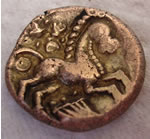 |
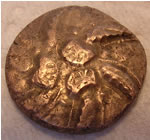 |
 |
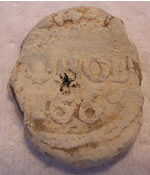 |
|
45 BC Addedomaros Celtic gold full stater found by Ark Gary 'Well, this is a nice one, and as you say with those intriguing symbols above the horse visible. What they seem to be is three horse's muzzles - on some dies they are virtually identical to the muzzle actually on the horse. Curiously, at roughly the same time that Addedomaros was using this motif on his staters, so was Commios, down in Hampshire. In fact since Commios is generally dated a little earlier than Addedomaros, it's not impossible that the latter encountered one of Commios's staters and decided to copy this feature. It quite often appears blundered, which suggests that the die engravers didn't always know what they were looking at. I'll record this one as CCI 05.0603, and I look forward to more! |
George 1st
1714 - 27 milled silver sixpence crude pendant
|
1756 Russian
bale seal
|
|
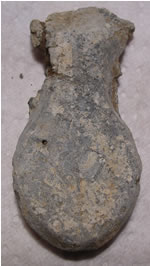 |
Pilgrim ampulla - holly water bottle made of lead 12th to 15thC, These ampulla were brought from pilgrimage places as a souvenir |
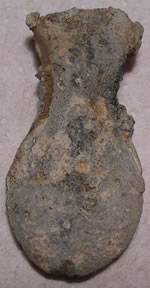 |
|
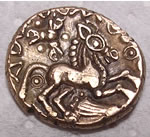 |
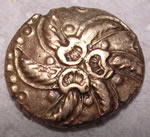 |
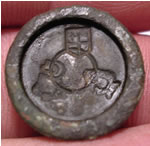 |
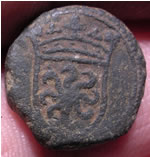 |
|
Stunning
45 BC Addedomaros Celtic gold full stater
found by Florida Don
|
Georgian
period trade weight Lincoln Hallmark
|
1475 AD 'Sun in shield' Bronze uniface coin weight for the 'ecu au soleil' French gold coin | |
 |
 |
 |
 |
|
1570 Elizabeth
1st hammered silver groat ( 4 pence) 'clipped'
|
4thC Roman
'House of Contantine' bronze
|
||
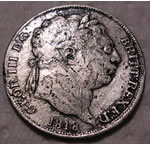 |
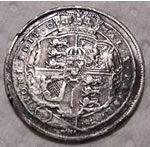 |
 |
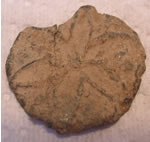 |
|
1818 George
III milled silver sixpence
|
Huge early
key fragment - not researched it yet
|
Large 15thC
lead token - flower pattern
|
|
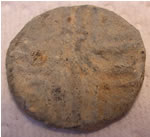 |
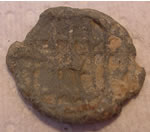 |
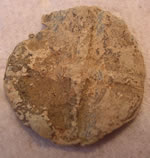 |
 |
|
Large 15thC
lead token - long cross
|
Large 15thC
lead token- weave pattern
|
15thC lead
token - long cross
|
Gold Rose
Ryal of James 1st coinweight 1605 AD 12.19g - 21.36mm sq - Underweight
by 1.6 gams LOL
|
 |
 |
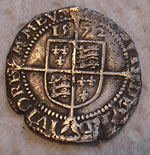 |
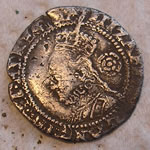 |
|
Early Medieval
cross mount
|
Very unusual
Royal Artillery button with gilding
|
1572 Elizabeth
1st hammered silver half groat ( 2pence)
|
|
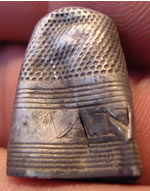 |
 |
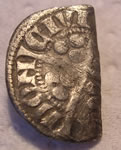 |
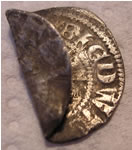 |
|
Mid 1700's
silver thimble with the initials AM - neat find
|
Post Medieval
belt mount
|
Edward 1st to 3rd - Medieval Longcross hammered silver penny London mint - will ID after straightening |
|
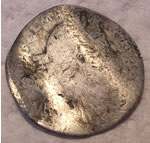 |
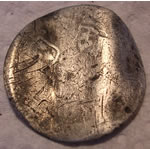 |
 |
 |
|
1696 William
III milled silver love token
|
Medieval
long cross cut half hammered silver penny
|
||
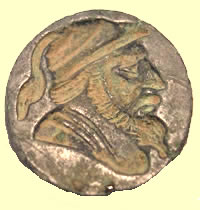 |
 |
||
|
Bronze face
with the initials MW on the reverse - Seal matrix ? Probably 18thC - fantastic
artefact
|
|||
 |
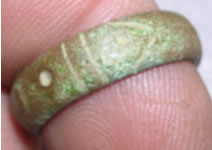 |
||
|
Huge Roman
bronze pot leg with decoration
|
Decorated
ring mid 17thC with fake hallmarks of 18 carat gold LOL
|
||
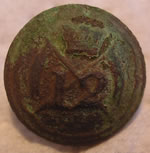 |
 |
 |
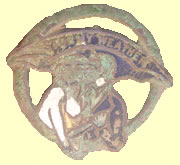 |
|
12th
Lancers button
The 12th Dragoons were a British cavalry regiment raised in 1715 in Berkshire. They were later renamed the 12th Lancers. They fought at Waterloo and during the Great War were part of the 5th Cavalry Brigade. |
Some great
early decoarted crotal bells turning up and after cleaning still ringers
LOL
|
George II
copper hammered on it's edges to form a coin weight or love token ? Several
have been found
|
'Stormy Weather
' enamelled badge - no idea what that means LOL
|
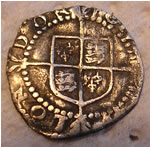 |
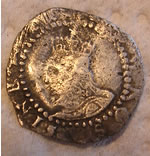 |
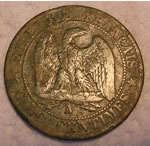 |
 |
|
1500's Elizabeth 1st hammered silver penny mint mark blurred |
1865 Napolean
III
|
||
 |
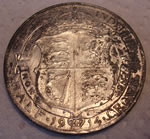 |
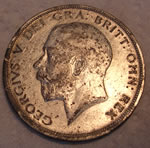 |
|
|
Mark at the UCRF has ID'd this early Roman 65 AD Nero As 22.76mm - 4.2g #That
would be "ARA PACIS" The Altar of Peace. It's just a large,
squarish object that corresponds pretty well to the blob on your coin.
Positive ID for Nero. According to RIC, the years the type was minted
were 65 & 66 A.D. and only at Lugdunum (modern Lyon). Some sub-types
are considered "common" some less so, but I doubt we'll ever
be able to read enough of the obverse inscription to say more than that
it's the ARA PACIS type'. |
1914 milled
silver Halfcrown (30 pence) forgery
|
||
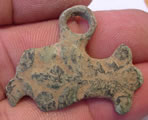 |
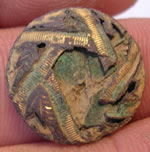 |
 |
 |
|
17thC decorated
sword hanger
|
Decorated
gilded button
|
96th Regiment
of foot button
|
Alnage lead
cloth seal
|
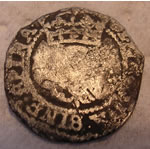 |
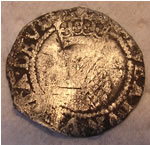 |
 |
 |
|
1605 James
1st hammered silver half groat ( 2 pence)
|
1800's Victorian
milled silver 3 pence
|
||
 |
 |
 |
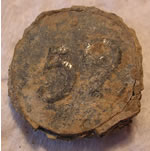 |
|
1279 AD Edward
1st hammered silver farthing 13.37mm - 0.33g possibly type 7
|
Early French
Napoleonic 82nd regiment button
|
Colonial
wars period 58th Regiment of foot button
|
|
 |
 |
||
|
1696 William
III milled silver shilling and a 1697 sixpence
|
|||
 |
 |
||
|
4thC Valens - 364-378 A.D Roman bronze with the info supplied by Mark at the URF 'That
is the emperor Valens - 364-378 A.D. Obverse inscription DN VALENS PF
AVG diademed, draped and cuirassed bust right. The SECVRITAS REIPVBLICAE
AE3's of him and his brother are very, very common. His brother Valentinian
I who pre-deceased him in 375 due to not waiting four hours for brother
Valens to arrive, hoping to claim the "glory" for his imagined
"victory" at Hadrianople for himself, is one of the classic
hubris stories of the later Empire. Valentinian and hiis legions were
ridded down by the Gothic cavalry employing their new invention - the
stirrip - and anihilated. One of the greatest disasters to befall the
Empire at this time I can't make out the mintmark on the reverse - perhaps
some cleaning would reveal sufficient tops of letters in the exergue
to tell you what mint produced this piece. |
|||
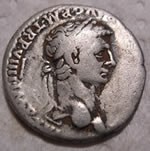 |
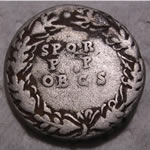 |
 |
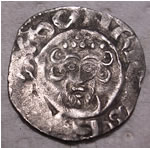 |
|
Claudius,
49-50 A.D. and is RIC I, 49 - frequency "R4"!
|
1199AD King
John short cross hammered silver penny
|
||
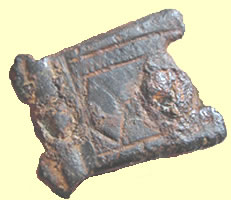 |
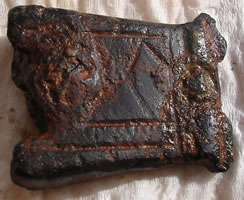 |
||
|
Medieval
decorated buckle with integral box chape
|
|||
 |
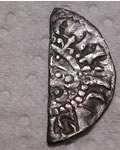 |
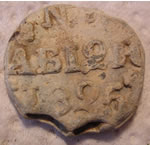 |
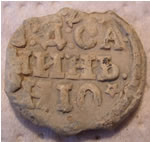 |
|
1247AD
Henry III voided hammered cut half silver penny
|
1825
Russian bale seal
|
||
 |
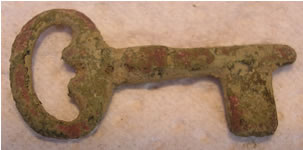 |
||
|
Post
Medieval decorated finger ring
|
17thC
casket key
|
||
 |
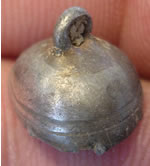 |
 |
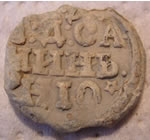 |
|
WWII
Army Educational Corp badge
|
Medieval
silver hawking bell fragment
|
1718
Russian bale seal
|
|
 |
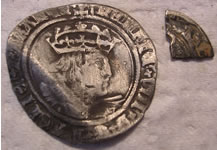 |
||
|
1526
AD Henry VIII hammered silver groat (4 pence) and a 14thC long cross 1/4
penny
|
|||
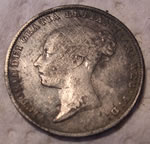 |
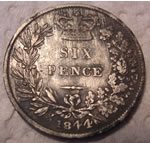 |
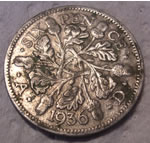 |
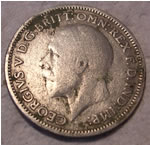 |
|
1844 Victorian
silver sixpence
|
1936 George
V silver sixpence
|
||
